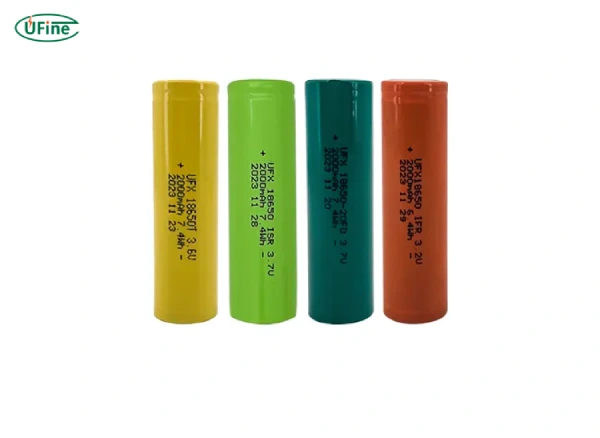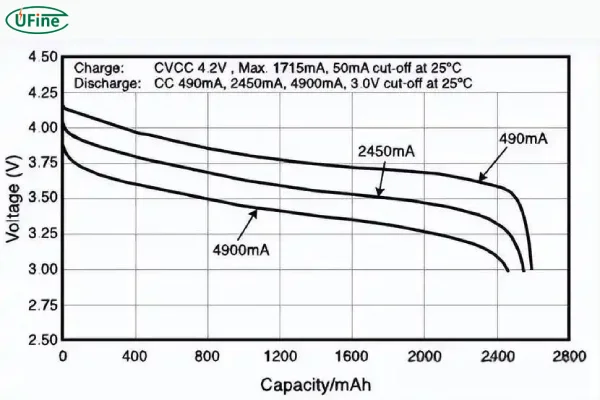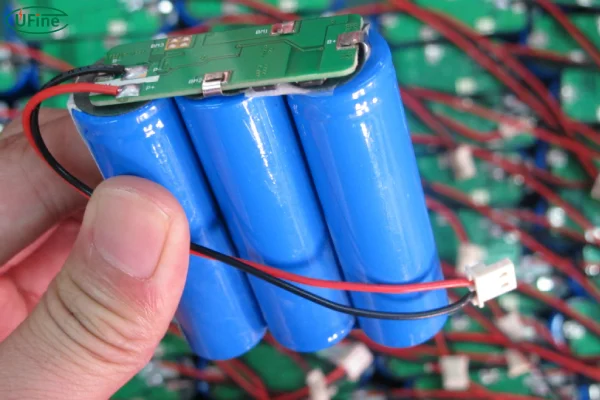
- Part 1. What is the 3.7V 18650 battery?
- Part 2. Learn 18650 battery voltage
- Part 3. 18650 Voltage curve
- Part 4. 3.7v 18650 batteries in series and parallel
- Par 5. The chemistry of 3.7v 18650 battery
- Part 6. How to choose a suitable 3.7V 18650 battery charger?
- Part 7. What battery Can replace a 3.7V 18650 battery?
- Part 8. What is the difference between the 3.6 V and 3.7 V 18650 battery?
- Part 9. 2600mah 3.7v rechargeable 18650 battery
- Part 10. 18650 battery 3.7v 2200mah
Part 1. What is the 3.7V 18650 battery?
The 3.7V 18650 battery is a rechargeable lithium-ion cell with a standard nominal voltage of 3.7 volts. Its name derives from its dimensions: 18mm in diameter and 65mm in length. Widely utilized in various electronic devices such as laptops, flashlights, and power tools, this battery offers a balance of compact size and high energy density.
The 3.7V rating signifies its average voltage output during discharge, ensuring consistent power delivery. With capacities ranging from around 1500mAh to over 3000mAh, these batteries cater to diverse energy requirements.
Part 2. Learn 18650 battery voltage
18650 battery voltage is one of the important parameters of an 18650 lithium battery. Normally, the voltage of a single 18650 cell is as follows:
1. Nominal (Working) voltage
The core of the 18650 battery voltage is the working voltage, also called the nominal voltage, which is 3.7V. This is equivalent to three nickel-cadmium or nickel-metal hydride batteries connected in series. Some battery manufacturers design the working voltage of 18650 batteries to be 3.6V.
2. Charging limit voltage (Maximum voltage)
This is the maximum limit for the 18650 battery voltage, which is 4.2V. The 18650 battery charging process increases the 18650 battery voltage from 3.7V during operation to 4.2V. The process ends, indicating that the battery is fully charged. If it exceeds 4.2V, it is overcharged, which will cause damage to the 18650 battery.
3. Discharge termination voltage (Minimum discharge voltage )
That is the voltage of the 18650 battery drops to the lowest working voltage, which is unsuitable for continuous discharging, which is 2.75V. If the battery is placed below the cut-off voltage, it is over-discharged. Over-discharging the battery will damage the electrode structure of the 18650 battery, causing irreversible reactions of lithium ions, seriously affecting the life of the 18650 battery.
Overcharging and over-discharging will cause serious damage to the 18650 battery. Therefore, most 18650 batteries have PCBs that allow the 18650 battery voltage to automatically stop when it reaches the upper and lower limits.
Part 3. 18650 Voltage curve
This 18650 voltage curve is the discharge curve of a Panasonic 2550mAh lithium-ion battery using lithium cobalt oxide as the positive electrode material. The three curves from top to bottom represent the changes in voltage and capacity when using three different discharge currents.
First, during the charge and discharge process, the voltage changes continuously. Taking 490mA as an example, the open circuit voltage is 4.2V when the battery is fully charged. As the discharge progresses, the voltage (vertical axis) slowly decreases, and the amount of electricity discharged (horizontal axis) gradually increases until the voltage begins to drop sharply at 3.5V. Although the voltage has been changing throughout the discharge process, for simplicity, only the average value of the flat discharge part of the curve, 3.7V, is marked as the battery voltage. This voltage is also called the nominal voltage.
This voltage is measured under low current and room temperature conditions, and will decrease as the discharge current increases and the temperature decreases.
Another important factor affecting the battery voltage is the positive and negative electrode materials. The above-mentioned Panasonic battery uses lithium cobalt oxide and graphite as the positive and negative electrode materials, which are also the standard materials for the entire lithium battery industry in the past few years. With the application of new materials in batteries, some 3.6V or 3.8V lithium batteries have appeared in the past two years, which use different positive electrode materials. Compared with lithium cobalt oxide batteries, they can improve energy density, that is, store more electricity per unit weight and volume.
Part 4. 3.7v 18650 batteries in series and parallel
To customize the power output and capacity, 3.7V 18650 batteries can be connected in series, parallel, or both:
-
Parallel Connection
In parallel, the voltage remains the same, but the capacity adds up. For example, two 2200mAh 3.7V cells connected in parallel will form a battery pack with 3.7V and 4400mAh. -
Series Connection
In a series, the voltage increases while the capacity stays the same. For example, three 2200mAh 3.7V cells connected in series would form a pack with 11.1V but the same 2200mAh capacity. -
Series-Parallel Combination
Combining both methods allows for both increased voltage and capacity. For example, three 2200mAh cells in series and two sets of these in parallel would give you 11.1V and 4400mAh.
Par 5. The chemistry of 3.7v 18650 battery
- LiCoO2 (Lithium Cobalt Oxide): Known for its high energy density, LiCoO2 is often used in devices where compact size and high performance are essential, such as in smartphones and laptops.
- LiFePO4 (Lithium Iron Phosphate): LiFePO4 is known for its safety, longer lifespan, and thermal stability, making it a better choice for applications requiring consistent performance over time, like electric vehicles and power tools.
- NMC (Nickel Manganese Cobalt): NMC is favored in electric vehicles and energy storage solutions due to its balance of energy density, cost, and safety.
Part 6. How to choose a suitable 3.7V 18650 battery charger?
Choosing the right charger for your 3.7V 18650 battery is crucial for maintaining its performance and longevity. Here are some key factors to consider:
-
Match the Chemistry
Ensure the charger is compatible with the battery’s chemistry—LiCoO2, LiFePO4, or NMC—as each type may require different charging profiles. -
Voltage and Current Output
The charger should output 4.2V and be able to provide the correct current (usually between 0.5C and 1C) to avoid overcharging and potential damage. -
Safety Features
Look for chargers with overcharge protection, short circuit protection, and temperature monitoring to enhance safety during the charging process. -
Charging Speed
If you don’t need a fast charge, opt for a slower charger to reduce heat generation and extend battery life. Fast chargers may shorten battery lifespan if used regularly. -
Compatibility
Ensure the charger supports the size and capacity of your 18650 battery. Some chargers work with multiple sizes and chemistries, providing added flexibility.
Part 7. What battery Can replace a 3.7V 18650 battery?
If you need a replacement for a 3.7V 18650 battery, the most common options depend on the device you’re using it in. Here are some alternatives:
-
Other Lithium-Ion Batteries
Many devices that use the 18650 battery can also be compatible with other 18650-sized lithium-ion batteries with similar voltage ratings (3.7V nominal). However, make sure to match the capacity (mAh) and discharge rate (C rating) to ensure proper performance. -
LiFePO4 Batteries
LiFePO4 batteries, often found in higher-performance applications, can be used as a replacement for 18650 batteries, especially in cases where thermal stability and safety are more important than high energy density. -
18650 Lithium-Ion Batteries with Higher Capacity
If your device supports it, you can upgrade to an 18650 battery with a higher mAh rating for extended runtime. Just ensure that the battery is within the voltage range and is compatible with your device’s power requirements. -
Other Lithium-Based Batteries
While not always a direct replacement, some lithium-ion or lithium-polymer (LiPo) batteries may fit the form factor and voltage requirements of certain devices. However, they may require modifications to the device or an adapter.
Part 8. What is the difference between the 3.6 V and 3.7 V 18650 battery?
Here’s a concise list outlining the similarities and differences between 3.6V and 3.7V 18650 batteries:
3.6V and 3.7V 18650 batteries Similarities:
- Both are variants of the 18650 lithium-ion cell.
- They share similar physical dimensions and cylindrical shape.
- Both are rechargeable batteries commonly used in various electronic devices.
- They typically feature similar chemistry, consisting of lithium-ion technology.
3.6V and 3.7V 18650 batteries Differences:
1. Nominal Voltage:
- 3.6V 18650 battery: Nominal voltage of 3.6 volts.
- 3.7V 18650 battery: Nominal voltage of 3.7 volts.
2. Performance:
- The 3.7V variant may offer slightly higher energy density and capacity than the 3.6V version.
- The 3.7V battery might increase power output and potentially longer runtime in certain applications.
3. Compatibility:
- Both batteries are generally compatible with various devices and applications.
- The 3.7V variant might be preferred for devices that require higher voltage thresholds or demand more power.
4. Voltage Fluctuation:
- The actual voltage output of both batteries can vary based on factors such as charge level, temperature, and load conditions.
- Despite nominal voltage differences, both batteries exhibit similar fluctuations during operation.
5. Usage:
- Depending on specific application requirements, one variant may be chosen over the other to optimize performance and efficiency.
- Both variants are reliable power sources for portable electronics, power tools, and other devices.
While 3.6V and 3.7V 18650 batteries share many similarities in physical attributes and applications, their nominal voltage ratings and potential performance differences distinguish them from each other, making each variant suitable for particular use cases.
Part 9. 2600mah 3.7v rechargeable 18650 battery
The 2600mAh 3.7V rechargeable 18650 battery offers a balanced capacity and size, delivering 9.6Wh of power in a compact 18650 casing. This makes it ideal for vaporizers, flashlights, and power banks, providing a reliable energy source for many everyday devices. Popular brands like Samsung, LG, and Ufine ensure long battery life, maintaining over 80% capacity after 500 charge cycles.
Part 10. 18650 battery 3.7v 2200mah
The 2200mAh 3.7V 18650 battery is slightly smaller than the 2600mAh version but still offers solid performance. It’s perfect for devices that require a compact design, such as wireless earbuds or wearable electronics. Despite its smaller capacity of 8.1Wh, it provides reliable power while maintaining a space-saving cylindrical shape.
Related Tags:
More Articles

Battery Load Test: A Comprehensive Guide
Step-by-step battery load test guide for car, solar & industrial use. Learn how to load test a battery, interpret voltage charts, and avoid common mistakes.
The Comprehensive Guide to Battery Balancing and Battery Balancer
Discover how battery balancers improve lithium battery performance, lifespan, and safety. Learn types, functions, and tips to choose the right balancer.
What Is the Best Voltage for a Chainsaw Battery?
Compare 12V-80V chainsaw batteries for light pruning, medium firewood, and professional cutting. See best battery chainsaw with runtime charts and safety tips.
Lithium VS. Alkaline Batteries: A Comprehensive Comparison
Lithium batteries last 3–7× longer than alkaline and perform better in cold weather. Compare lifespan, cost, safety, and best uses to choose the right battery.
Comparing Lithium-Sulfur and Lithium-Ion Batteries: Which is Right for You?
Compare lithium-sulfur (Li-S) and lithium-ion batteries on energy, lifespan, cost, safety, and applications. Best choice for drones, EVs, and electronics.







